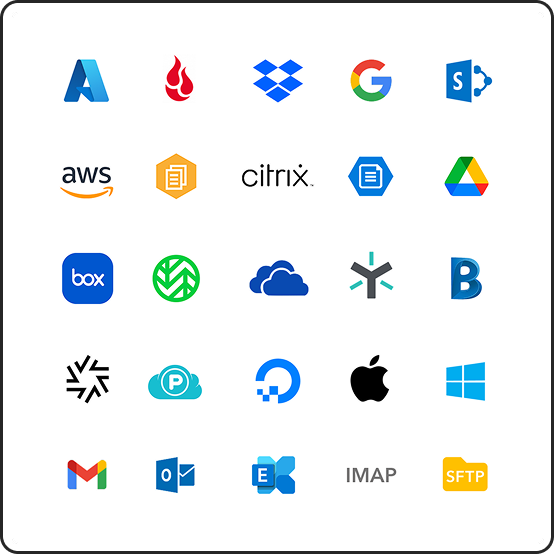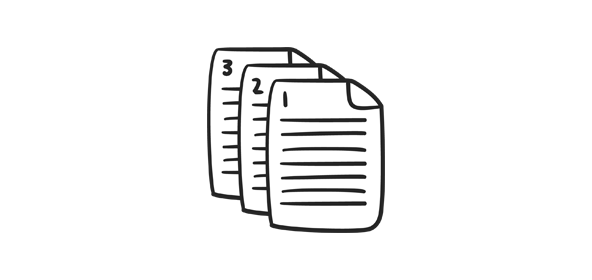As two popular cloud storage platforms, Google Workspace and Egnyte are used by organizations and enterprises around the world for data storage and collaboration. Moving data between the two platforms doesn't have to be hard, and Movebot makes Google to Egnyte migrations simple. All you have to do is connect your accounts, choose what data to move, and start your transfers while Movebot does the rest.

Preparing to migrate from Google to Egnyte
Because Google has fewer restrictions than Egnyte, you'll want to make sure your data meets Egnyte's requirements before trying the migration. Most of the platform differences Movebot can handle for you, but it's helpful to know what to expect in case you want to make any changes manually or want to know how some of the differences will be handled ahead of time.
File and folder naming
One thing that Google does differently from other storage platforms is how it deals with file and folder naming. In a traditional file system, there are several character names that can't be used because they function as something else. Slashes and dots, for instance, are disallowed by virtually every storage system there is.
However, Google doesn't have these same restrictions. You can name a file whatever you want. It can even be purely symbols such as ./&/?. And the same goes for folder names. Characters that would normally designate a path are fine to use in directories in Google. On top of that, Google Workspace allows for duplicate names too, even at the same location. In larger directories, it's possible to have multiple files with the same name, and it could be entirely unintentional.
Where this becomes an issue is when moving into a platform that doesn't support this structure, such as Egnyte. When migrating from Google to Egnyte the files and folders will need to be in a state that Egnyte can process and store. If you try to move a file or folder without doing this, it will throw an error and won't be migrated.
Fortunately, Movebot can help with its filename sanitization and deduplication features. Filename sanitization will clean out characters that aren't allowed in the destination, while deduplication will take identical filenames and add a deduplication prefix so they can be stored in Egnyte. You can also apply custom filename transformation rules for greater control over how the files will be named after the migration.
Storage limits
There is a possibility of storage limits of Egnyte being an obstacle for a migration depending on the account types you are moving to and from. Older G Suite Business accounts offered unlimited storage across the organization, which could potentially be a problem depending on the Egnyte plan the organization is on. Newer Google Workspace subscriptions include up to 5TB per user, while Office and Business plans in Egnyte include 5TB and 10TB respectively. Enterprise includes a custom amount.
Because most Google accounts have higher limits, double-check that the Egnyte account will be able to hold all of the data from Google. If not, there are a couple of options. One is to upgrade the account level. Another is to exclude data from the migration.
Movebot can help by doing this as part of the project setup. With Movebot, you aren't forced into moving the entire Google Workspace to Egnyte. Instead, you have full control of the data you want to move. Filters let you choose from options such as creation date and mod time, and after connecting your platforms you can make transfers down to a single folder if you want. These features mean you make sure you're only moving the data you actually need.
So what about the data you don't need? You can delete it if you'll never need it, or add it to another project in Movebot. For example, there may be 13TB out of 16TB that is actually needed for the migration. You could move the 13TB and then transfer the other 3TB to another platform, like archival or cold storage to save on storage costs.
Proprietary Google Files
Something else to be aware of when moving out of Google is the proprietary doctypes. Google's suite of apps for word processing, spreadsheets, and presentations allow for simultaneous collaboration where multiple users can work on the same file at the same time.
Since these are Google's own apps with their own proprietary filetypes, they only work in the Google ecosystem. They can't simply be moved to a new platform and function in the same way as they did in Google. The files will need to be converted to something usable instead.
Fortunately, Movebot can do these conversions as part of the migration if you leave the default setting enabled. Automatic doctype conversion will find these proprietary file types and convert them into the Microsoft Office equivalent. From there, they can be opened by any compatible application and used in that format.
Google to Egnyte migrations with Movebot
Migrating from Google to Egnyte is simple with Movebot. All you need to do is follow our simple 3-step PAC process and you're ready to move.
Plan
Planning is the first step, and includes reviewing the data for the situations above. Make sure you have enough storage space and a plan for how to update file names that won't work in Egnyte. Have a plan to convert Google file types or let Movebot do it automatically.
When Google Workspace is your source in Movebot, there are also Google-specific options that you can enable to make sure your files arrive as expected into Egnyte. Searching for unreachable content helps find content that may have been accidentally orphaned due to Google's sharing structure. Excluding SharedWithMe Content means only files that a user owns will be migrated; if disabled, files the user owns as well as a copy of any files shared with them will be copied. Excluding files/folders with multiple parents can stop duplicates when migrating from a Legacy Google Drive.
Because Movebot lets you choose what data to move, you should also decide on what data needs to be migrated to Egnyte. If files don't need to be migrated, know where those are and how to find them. Keep in mind that Movebot doesn't actually move files because of the risks associated, but rather makes a copy of the files in Google Workspace for Egnyte. This means if you want to delete files, you'll need to do so separately from the migration.
Advance
Advance is the second stage, where you start moving data. First, you'll need to connect the accounts. The accounts only need to be connected once, and can then be used across multiple migration projects Egnyte, you'll need the Egnyte domain and then you can link to Egnyte using OAuth.
Google Workspace is more complicated for the initial setup. The account connected to Movebot needs to have permission to move files, so it's best to use an Admin account. Enter the domain and then click to create a service account. This will generate a client ID, which you'll need to add as part of delegating domain wide authority required to give Movebot the right permissions.
After connecting the accounts, go through the project settings and update anything needed to match your requirements. Next, map the users and folders from the plan to create transfers. Transfers can be run one at a time or multiple can be run simultaneously. Movebot lets you break down the migration into unlimited transfers, including an option not to include previously mapped folders so that you don't end up with duplicates.
Cutover
Cutover is the last stage of the migration, starting once the bulk of the files have been migrated. When a transfer finishes, Movebot will generate a post-migration report that shows the number of files moved, the amount of data transferred, and other useful information like if there were any failures. You can then rerun failures directly from the report screen or run delta migrations there or later on at any point
Delta migrations in Movebot check for any new or modified files in the source and then copy only those into the destination. Because Movebot copies files instead of moving them, this method of delta migrations also means that users can continue working in the Google Workspace account even while the migration is in progress. Simply run delta migrations until all the files are moved, transition the users out of using Google Workspace, and move any updated files. You can run unlimited delta migrations to ensure that all necessary files are migrated successfully.
Try Movebot for Google to Egnyte Migrations
Movebot makes migrating from Google Workspace to Egnyte simple. All you have to do is follow the simple three-step PAC process and Movebot will handle the rest. Move terabytes per day with a data migration tool that just works.
Want to make sure Movebot is a good fit for your project? You can try Movebot with 250GB free, with no credit card required. Simply sign up and go, and you can start moving files in minutes. Register for an account now to get started.






